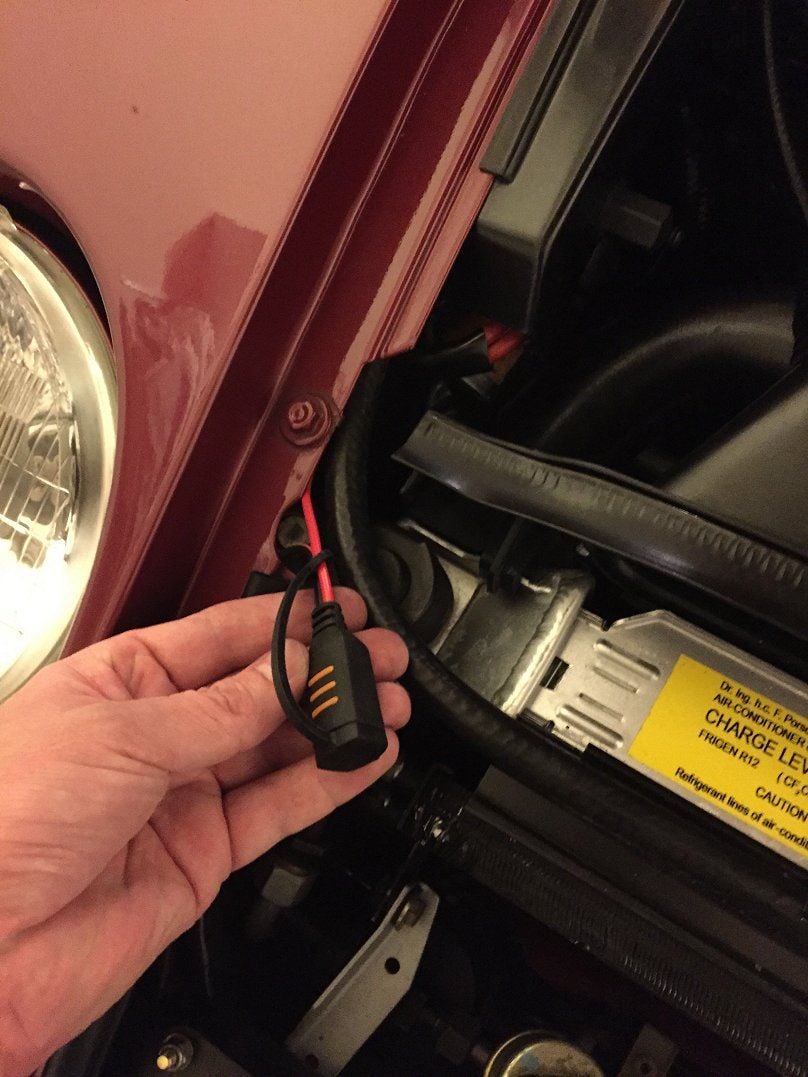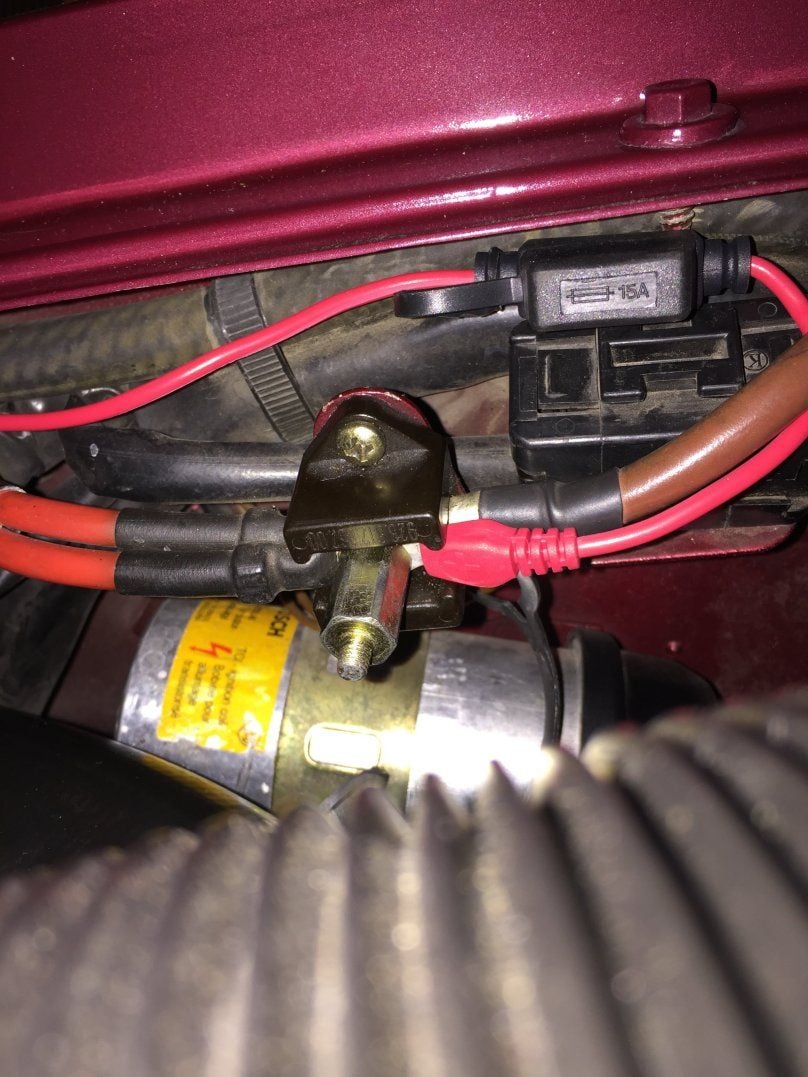Most Efficient Methodology For Determining Cause of Battery Drain?
#1
Addict
Lifetime Rennlist
Member
Lifetime Rennlist
Member
Thread Starter
Recently, my battery has been going dead after about 2 days of non-driving.
I'm pretty sure the battery is OK as it takes a full charge, but I haven't had a load test done on it yet.
I've not done anything recently to the car that I can think of that would cause a drain.
What is the best method to determine the cause of the drain?
I have a good multimeter.
Thanks.
I'm pretty sure the battery is OK as it takes a full charge, but I haven't had a load test done on it yet.
I've not done anything recently to the car that I can think of that would cause a drain.
What is the best method to determine the cause of the drain?
I have a good multimeter.
Thanks.
#2
Rennlist Member
The best way I found was to get an inline tell tale voltage meter that plugs into your CE panel in the fuse spots. Shows a drain. You have to sit in the car with the doors closed and wait for the lights to go out. Then start moving it from fuse spot to fuse spot. Then check out the ones with the voltage drain and that should do it. Look under fuse buddy on amazon.
#3
Team Owner
Other thing to do is remove the parcel tray and upper CE panel board then shoot the panel with an IR gun,
find the hot relay.
thats the one thats sticking.
once the panels are out of way,
the use the gun to get a baseline.
then go for a drive about 15 miles ,
park the car shut it off wait ten mins then use the gun again,
roll the windows down so you dont have to open the door to do the test.
Usually its a blower or HVAC relay thats sticking,
or it could be the defrost relay if you have used that.
NOTE the DEF system is best used by twisting it on instead of pushing,
this way you control when its shut off not the internal timer
find the hot relay.
thats the one thats sticking.
once the panels are out of way,
the use the gun to get a baseline.
then go for a drive about 15 miles ,
park the car shut it off wait ten mins then use the gun again,
roll the windows down so you dont have to open the door to do the test.
Usually its a blower or HVAC relay thats sticking,
or it could be the defrost relay if you have used that.
NOTE the DEF system is best used by twisting it on instead of pushing,
this way you control when its shut off not the internal timer
#4
Nordschleife Master
Alternative way is to hook up an ammeter to the battery, to see what the parasitic draw is.
Then go to the CE panel, and start pulling fuses while a helper watches the meter. Whatever "fuse pull" makes the draw drop is likely your culprit.
Keep in mind that there may be more than one circuit doing this.
One more thought: I seem to recall that there have been cases of this where unhooking the battery or the "culprit circuit" will shut it down so that it won't draw power until the car is started up again. Hooking up the meter across the ground cable, then unhooking the ground so that the meter reads properly was suggested.
Then go to the CE panel, and start pulling fuses while a helper watches the meter. Whatever "fuse pull" makes the draw drop is likely your culprit.
Keep in mind that there may be more than one circuit doing this.
One more thought: I seem to recall that there have been cases of this where unhooking the battery or the "culprit circuit" will shut it down so that it won't draw power until the car is started up again. Hooking up the meter across the ground cable, then unhooking the ground so that the meter reads properly was suggested.
#5
Team Owner
its easier to find the warm relay, than disconnecting wires,
try it first,
you will be amazed
try it first,
you will be amazed
#7
Chronic Tool Dropper
Lifetime Rennlist
Member
Lifetime Rennlist
Member
Randy--
Harbor Freight sells a cute little ammeter that plugs into the fuse sockets. Fine for some things in its native mode, but better as a handy 30A-capable digital ammeter. Else use a good DMM with 10A capability. Wire either in series with the battery ground strap, without disconnecting the strap until the meter is installed. Easiest way is to connect the ammeter to the ground post on the battery, and to chassis ground someplace other than the ground strap bolt. The handy ground screw above the battery in the spare well is fine. Once firmly connected, lift and isolate the battery ground strap at the rear apron. Now the meter shows all current flowing from the battery. Start pulling and replacing fuses one by one to find the one that's flowing current. Remember that there are a few circuits not fused in the CE panel, like the rear hatch motor park circuit.
Alternatives: Use your DMM set to read millivolts, and equipped with a set of needle-end probes. Tape the two door switches so the lights stay out with the door(s) open. Then use the meter to measure the voltage drop through each fuse. The fuses have tiny openings over each blade, convenient place to insert the needle probes. The fuse is a resistor, so any current flowing through it will cause a voltage drop. Should be zero unless there's current flowing through it. This is a much safer but way less accurate method in that you won't be able to easily determine how much current is flowing through that circuit. With no parts removed in the process though, it's a great way to narrow down your search.
Diligence will pay off.
Look also for idle or sense current going to audio components. These drains are common in amplifiers and some head units where they 'listen" for a source signal to turn them on. Head units sometimes have live station, clock and other "memories" that require a tiny keep-alive current. That tiny current drain, over weeks and months, will drain the battery.
----
If you aren't 100% confident in your electrical skills, grab a handful of the "free with any purchase" H-F digital multimeters. I keep a pack of fuses for my Fluke DMM, but honestly it's easier to keep a small supply of the "free" H-F throwaways than to disassemble the Fluke for a fuse change. I'm lazy.
Harbor Freight sells a cute little ammeter that plugs into the fuse sockets. Fine for some things in its native mode, but better as a handy 30A-capable digital ammeter. Else use a good DMM with 10A capability. Wire either in series with the battery ground strap, without disconnecting the strap until the meter is installed. Easiest way is to connect the ammeter to the ground post on the battery, and to chassis ground someplace other than the ground strap bolt. The handy ground screw above the battery in the spare well is fine. Once firmly connected, lift and isolate the battery ground strap at the rear apron. Now the meter shows all current flowing from the battery. Start pulling and replacing fuses one by one to find the one that's flowing current. Remember that there are a few circuits not fused in the CE panel, like the rear hatch motor park circuit.
Alternatives: Use your DMM set to read millivolts, and equipped with a set of needle-end probes. Tape the two door switches so the lights stay out with the door(s) open. Then use the meter to measure the voltage drop through each fuse. The fuses have tiny openings over each blade, convenient place to insert the needle probes. The fuse is a resistor, so any current flowing through it will cause a voltage drop. Should be zero unless there's current flowing through it. This is a much safer but way less accurate method in that you won't be able to easily determine how much current is flowing through that circuit. With no parts removed in the process though, it's a great way to narrow down your search.
Diligence will pay off.
Look also for idle or sense current going to audio components. These drains are common in amplifiers and some head units where they 'listen" for a source signal to turn them on. Head units sometimes have live station, clock and other "memories" that require a tiny keep-alive current. That tiny current drain, over weeks and months, will drain the battery.
----
If you aren't 100% confident in your electrical skills, grab a handful of the "free with any purchase" H-F digital multimeters. I keep a pack of fuses for my Fluke DMM, but honestly it's easier to keep a small supply of the "free" H-F throwaways than to disassemble the Fluke for a fuse change. I'm lazy.
Trending Topics
#9
Rennlist Member
I've posted this before. As long as you're trying to detect current flow in fused circuits, you can measure voltage drop across each fuse. It's easy on the bullet fuses, and the blade fuses each have two holes at the top made just for this purpose. There will be a few milivolts of voltage across fuses which have current flowing, like 0.021V. With no current it will be 0.000V. It's yes or no, not quantitative, but if you have current where there should be none, well there you are. With two electrodes and a voltmeter you can measure all the fuses in about a minute. Much easier than pulling and replacing fuses.
Work for fused circuits very well.
Good luck,
Dave
Work for fused circuits very well.
Good luck,
Dave
#10
Team Owner
Dave thats a great way to check for current flow and its easy if you dont open the door.
Curtis the simple answer is the relay thats warmer than the rest of them.
NOTE the 928 with a battery drain will usually be caused by a sticking relay,
thus the relay will be warmer then the rest of the unstuck relays, after a few mins of cool down time have elapsed
Curtis the simple answer is the relay thats warmer than the rest of them.
NOTE the 928 with a battery drain will usually be caused by a sticking relay,
thus the relay will be warmer then the rest of the unstuck relays, after a few mins of cool down time have elapsed
#11
Addict
Lifetime Rennlist
Member
Lifetime Rennlist
Member
Best thing i have done is wired a battery Tender connection to the jump post and a good ground. the connector is mounted on the inlet grill of the front bumper. It has become a habit just to plug in after each drive..never know when i will drive it again. Never fails to starts..cranks with authority.
Obviously, you need to find the cause of the drain first.
Obviously, you need to find the cause of the drain first.
#13
Rennlist Member
Best thing i have done is wired a battery Tender connection to the jump post and a good ground. the connector is mounted on the inlet grill of the front bumper. It has become a habit just to plug in after each drive..never know when i will drive it again. Never fails to starts..cranks with authority.
Obviously, you need to find the cause of the drain first.
Obviously, you need to find the cause of the drain first.





#14
Addict
Lifetime Rennlist
Member
Lifetime Rennlist
Member
Thread Starter
I used Stan's method to measure the relay temps, but that was inconclusive.
I see no holes on my blade fuse CE panel.
Ended up noticing that the interior lights were behaving wonky. Determined that one of the door panel lights had a broken connector and short.
It appears that was the culprit. Will monitor for a few days.
Ended up noticing that the interior lights were behaving wonky. Determined that one of the door panel lights had a broken connector and short.
It appears that was the culprit. Will monitor for a few days.
#15
Chronic Tool Dropper
Lifetime Rennlist
Member
Lifetime Rennlist
Member
Randy, look at a fuse, and see where there's a tiny hole in the fuse directly opposite each pin. One hole at each end of the face that has the number on it. Takes a needle probe, which you can fudge with a paper clip if needed. The holes are smaller than a standard meter probe will allow.
----
I found an inexpensive clamp-on DC ammeter that is supposed to be sensitive enough to read down to 10mA, up to 100A max, which is pretty darn small. I ordered one, and will try it and share the results.
----
I found an inexpensive clamp-on DC ammeter that is supposed to be sensitive enough to read down to 10mA, up to 100A max, which is pretty darn small. I ordered one, and will try it and share the results.
Last edited by dr bob; 01-10-2017 at 12:15 PM. Reason: Fixed double duplicate redundant word use. (that's really 8!)


 One day I'll need to refer again...subscribed.
One day I'll need to refer again...subscribed.